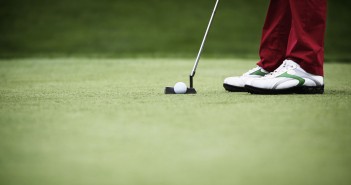One of the biggest misconceptions held by amateur golfers, in terms of scoring, is that they need to hit a lot of greens in regulation (GIR) in order to be a good golfer. If they are going to play golf to their desired level, they feel that they need to bomb the driver a mile down the fairway and be a great long iron player. As we’ll discuss here, this is a misguided focus that is costing them shots… a lot of shots!
Of course, we all want to drive the ball a long way, with accuracy, and to consistently find the middle of the green with our irons. Striking the ball beautifully is what Golf Loopy is all about. But the vast majority of golfers would shoot lower scores if they played more strategically, played the percentages, and kept the ball in play.
We asked over 400 students, of all abilities, to create a conservative strategy for their courses before playing ten rounds of golf. They were asked to only play shots where they thought they had a 60% or better chance of success, wherever possible. In Figure 1 we charted the number of greens in regulation that they hit against their playing handicap at the time the round was recorded.
We asked them to play “defensive aggressive” golf. To choose the percentage shot, and then to fully commit to that shot and attack the safe target.

Figure 1. % Greens in Regulation against Handicap.
So, when faced with a long par 4 with trouble off the tee, a mid-handicap player might leave the driver in the bag and play the hole as 2 mid- to short-irons and a wedge into the green, hope to make 2 putts and walk away with a bogey. A great wedge shot would give them the chance of a par, but the key is to avoid trouble, and to avoid penalty strokes at all costs.
Even better players, where they would normally be faced with a long iron second shot into a well protected green, were asked to lay up instead, to play sensibly off the tee and try to get their third shot close to the pin and make the putt for par.
On long par 3s with trouble close to the green, most students were asked to bail out, to deliberately miss the green and hit the ball into a safe position that enabled them to attack the pin with a chip or pitch & chip shot.
And with approach shots, rather than attack a “sucker” pin, they would play for the middle of the green – but aggressively, really focussing on a small target area.
The result? An average 6 shot improvement over their handicap.
Our students were surprised when we compared the results in Figure 1 to their normal GIR percentages – they were an improvement! Not only was playing strategically avoiding wasted strokes, it was actually improving their chances of getting on the dance floor. When they were playing at their very best, having a great ball striking day, they could beat these numbers, but their averages were worse. And on a bad day, the strategic rounds were far better than the aggressive ones – sometimes by 20 shots or more! Even our elite students hit more greens and shot lower average scores by playing this “defensive aggressive” golf.
Furthermore, the students’ “proximity to the hole” averages on their approach shots improved significantly, so they had a better change of making the first putt, and their 3-putt averages improved dramatically.
Students said they felt relaxed, more in control, and enjoyed their golf more. They were playing “within themselves” – mid-handicappers were playing to make bogey, no worse than double, and hoping for pars… and the pars kept coming. It was similar for the best golfers, except it was pars and birdies.
The lesson here is that you really don’t need to hit many greens in regulation in order to shoot low scores. In Figure 1, we can see that if you want to beat 90, all you need to do is play conservatively and hit 17% of greens, that’s just 3 greens in regulation. And to play off single figures, you only need to hit 7 greens!
All of the students in our experiment were losing more shots by being too aggressive, trying to play shots that were too difficult for their current ability, than they were gaining when their risks paid off.
Two 9 irons into the middle of the green, keeping it out of trouble, beats a 3-wood almost every time for the vast majority of amateur golfers. Lost balls and difficult lies are costing you far more than lay-ups ever will.
The added bonus was that every one of our students felt they were a better short-iron player after their ten strategic rounds. They were forced to play more short irons into difficult greens, to thread their way around the course, and to think carefully about the best place to miss. They were hitting their approach shots from the fairway, more often than not, and they became much better at distance control.
As their ball striking improved, using the Swing like a Champion system, they were able to hit the ball further with more accuracy and consistency. By the end of the experiment, the 30% shots that they had avoided at all costs, in the beginning, were now 60% shots that they could play with some confidence. Their patience paid off.
We’re not suggesting that you need to spend the rest of your golfing life bailing out. In order to play this game to a high level, you must be able to strike the ball well and hit the ball a good distance. The other important thing that Figure 1 tells us is that there is a direct correlation between GIR and handicap – improve your ball striking and distance and your handicap will fall. Not only will a better golfer hit more greens, but they are also likely to be getting the ball in better positions to make more putts, and their misses are likely to be far less costly.
But be patient, work on your swing efficiency and ball striking, play the percentages, and distance will soon come.
The next time you’re 250 yards from the green, leave your 3-wood (and your ego) in the bag. Yes, you can make the shot, but a better player wouldn’t even try. Find the best spot on the fairway for attacking the middle of the green with a wedge, and play to that spot aggressively. Better still, don’t leave yourself that distance in the first place! Play sensibly off the tee, avoiding penalty strokes at all costs, then lay up to your favourite wedge distance.
With this strategy, your scores (and your confidence) will improve dramatically and immediately.
Happy fairways!





